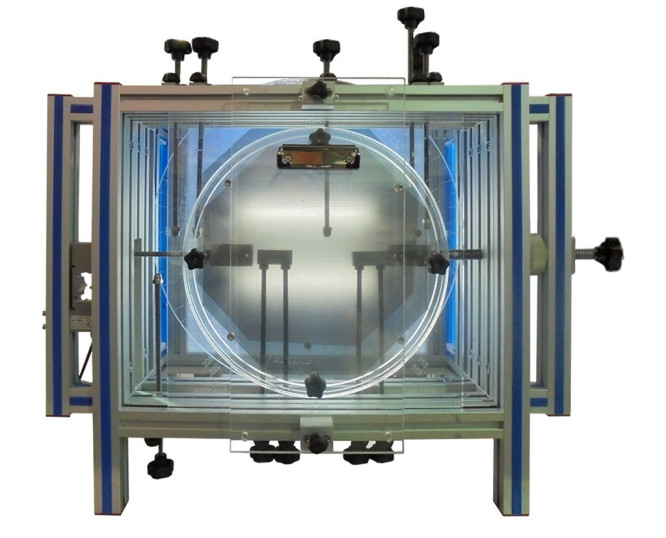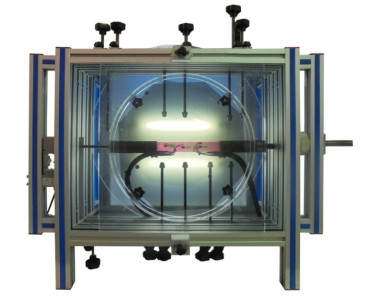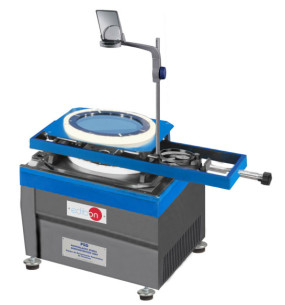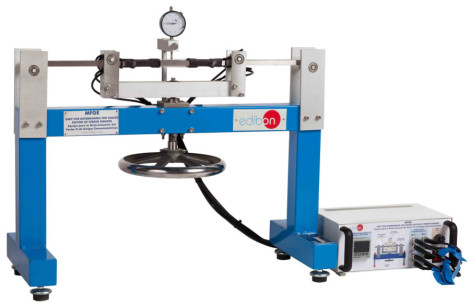EFO Gerät für Fotoelastizität
INNOVATIVE SYSTEME
Unit for photoelasticity practices, illustrating the subjects of the Photoelasticity theory, the Elasticity theory, Strength of Materials, and Structure theory.
Erweiterungen
Laboratorien
ÄHNLICHE NEUIGKEITEN
ALLGEMEINE BESCHREIBUNG
Unit for photoelasticity practices, illustrating the subjects of the Photoelasticity theory, the Elasticity theory, Strength of Materials, and Structure theory.
It is very suitable for the introduction and study of photoelasticity: optical elements, isochromatic, isoclinic, band order, band factor, edge tensionsing, etc.
Using this unit photoelastic experiments and practices of transparent test specimens (models) may be performed.
The different test specimens are subjected to loading by external forces and have poralised light shone through them.
A load application element can apply tensile, bending, compressive, and distributed and punctual loads to the specimen.
The stresses and strains occurring in the test specimen are represented as bright spots or figures of different colours, and we can visualise the distribution of stress.
We offer a wide range of test specimens for making a variety of practices and experiments.
These specimens show a full color and high contrast results and are also made of a special very hard material that avoids breaking during daily use.
ÜBUNGEN UND GEFÜHRTE PRAKTIKEN
GEFÜHRTE PRAKTISCHE ÜBUNGEN IM HANDBUCH ENTHALTEN
- Introduction to photoelasticity: optical elements, isochromatic, isoclinic, band order, band factor, edge tension sign, etc.
- Determination of principal stress difference.<
- Isochromatics.
- Illustration of the themes about elasticity, strength of materials and structures using photoelastic tests.
- Pure traction/optical-tensional law.
- Diametrically compressed disc.
- Ring with diametrical compression traction.
- Ring with diametrical compression.
- Plate with circular drill with traction.
- Comparison of the effects from different engraves in piece with traction.
- Pure traction in a piece with section linearly variable.
- Pure flexion.
- Simple flexion.
- Simple flexion, compound beams.
- Compound flexion.
- Compound central core of the section.
- Piece with a great curvature subjected to flexion.
- Arch built-in with a central charge.
- Triangular structure.
- Comparison of the structures.
- Comparison of the effect of different notches.
- Tardy compensation method (requires EFO-ICL).
MEHR PRAKTISCHE ÜBUNGEN FÜR DAS GERÄT
- Several other exercises can be done and designed by the user.
ÄHNLICHE VERFÜGBARE GERÄTE
Gerät für Fotoelastizität mit Künstlichem Visionssystem, computergesteuert (PC)
Gerät zur fotoelastischen Demonstration von Spannungen
ERGÄNZENDE AUSRÜSTUNG
Gerät für Fotoelastizität, computergesteuert (PC)
Gerät für Fotoelastizität mit Künstlichem Visionssystem, computergesteuert (PC)
Trainingsgerät für Dehnungsmessstreifen
Gerät zur Bestimmung des Dehnungsfaktors von Dehnungsmessstreifen
Gerät zur fotoelastischen Demonstration von Spannungen
QUALITÄT

KUNDENDIENST

 Cookie-Präferenzen
Cookie-Präferenzen










